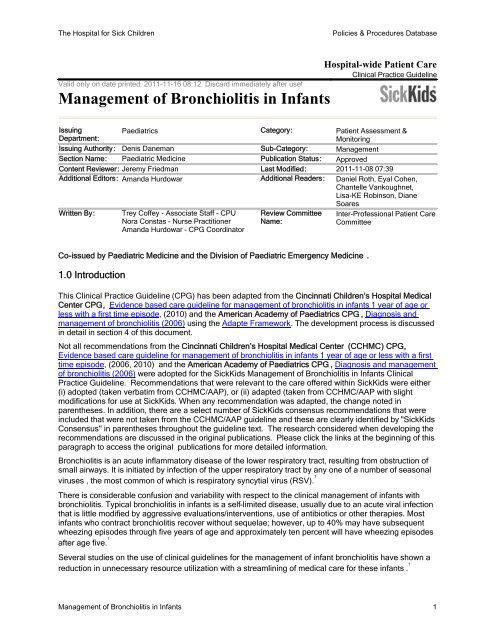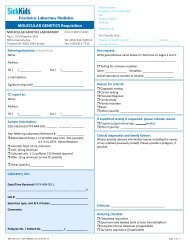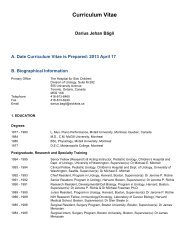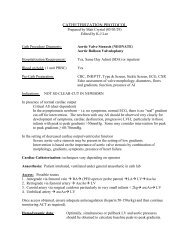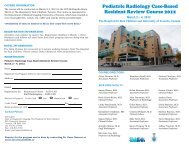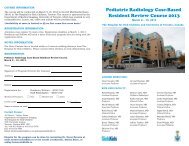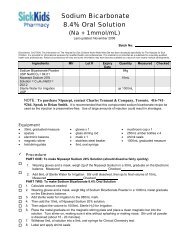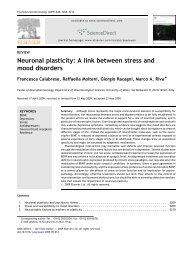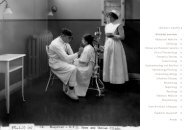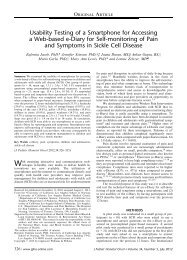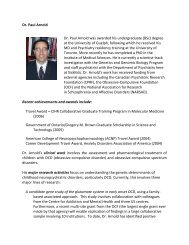Management of Bronchiolitis in Infants - The Hospital for Sick Children
Management of Bronchiolitis in Infants - The Hospital for Sick Children
Management of Bronchiolitis in Infants - The Hospital for Sick Children
You also want an ePaper? Increase the reach of your titles
YUMPU automatically turns print PDFs into web optimized ePapers that Google loves.
<strong>The</strong> <strong>Hospital</strong> <strong>for</strong> <strong>Sick</strong> <strong>Children</strong> Policies & Procedures Database<br />
<strong>Hospital</strong>-wide Patient Care<br />
Cl<strong>in</strong>ical Practice Guidel<strong>in</strong>e<br />
Valid only on date pr<strong>in</strong>ted: 2011-11-16 08:12. Discard immediately after use!<br />
<strong>Management</strong> <strong>of</strong> <strong>Bronchiolitis</strong> <strong>in</strong> <strong>Infants</strong><br />
Issu<strong>in</strong>g<br />
Paediatrics Category: Patient Assessment &<br />
Department:<br />
Monitor<strong>in</strong>g<br />
Issu<strong>in</strong>g Authority: Denis Daneman Sub-Category: <strong>Management</strong><br />
Section Name: Paediatric Medic<strong>in</strong>e Publication Status: Approved<br />
Content Reviewer: Jeremy Friedman Last Modified: 2011-11-08 07:39<br />
Additional Editors: Amanda Hurdowar Additional Readers: Daniel Roth, Eyal Cohen,<br />
Chantelle Vankoughnet,<br />
Lisa-KE Rob<strong>in</strong>son, Diane<br />
Soares<br />
Written By: Trey C<strong>of</strong>fey - Associate Staff - CPU<br />
Nora Constas - Nurse Practitioner<br />
Amanda Hurdowar - CPG Coord<strong>in</strong>ator<br />
Review Committee<br />
Name:<br />
Co-issued by Paediatric Medic<strong>in</strong>e and the Division <strong>of</strong> Paediatric Emergency Medic<strong>in</strong>e .<br />
1.0 Introduction<br />
Inter-Pr<strong>of</strong>essional Patient Care<br />
Committee<br />
This Cl<strong>in</strong>ical Practice Guidel<strong>in</strong>e (CPG) has been adapted from the C<strong>in</strong>c<strong>in</strong>nati <strong>Children</strong>’s <strong>Hospital</strong> Medical<br />
Center CPG, Evidence based care guidel<strong>in</strong>e <strong>for</strong> management <strong>of</strong> bronchiolitis <strong>in</strong> <strong>in</strong>fants 1 year <strong>of</strong> age or<br />
less with a first time episode, (2010) and the American Academy <strong>of</strong> Paediatrics CPG , Diagnosis and<br />
management <strong>of</strong> bronchiolitis (2006) us<strong>in</strong>g the Adapte Framework. <strong>The</strong> development process is discussed<br />
<strong>in</strong> detail <strong>in</strong> section 4 <strong>of</strong> this document.<br />
Not all recommendations from the C<strong>in</strong>c<strong>in</strong>nati <strong>Children</strong>’s <strong>Hospital</strong> Medical Center (CCHMC) CPG,<br />
Evidence based care guidel<strong>in</strong>e <strong>for</strong> management <strong>of</strong> bronchiolitis <strong>in</strong> <strong>in</strong>fants 1 year <strong>of</strong> age or less with a first<br />
time episode, (2006, 2010) and the American Academy <strong>of</strong> Paediatrics CPG , Diagnosis and management<br />
<strong>of</strong> bronchiolitis (2006) were adopted <strong>for</strong> the <strong>Sick</strong>Kids <strong>Management</strong> <strong>of</strong> <strong>Bronchiolitis</strong> <strong>in</strong> <strong>Infants</strong> Cl<strong>in</strong>ical<br />
Practice Guidel<strong>in</strong>e. Recommendations that were relevant to the care <strong>of</strong>fered with<strong>in</strong> <strong>Sick</strong>Kids were either<br />
(i) adopted (taken verbatim from CCHMC/AAP), or (ii) adapted (taken from CCHMC/AAP with slight<br />
modifications <strong>for</strong> use at <strong>Sick</strong>Kids. When any recommendation was adapted, the change noted <strong>in</strong><br />
parentheses. In addition, there are a select number <strong>of</strong> <strong>Sick</strong>Kids consensus recommendations that were<br />
<strong>in</strong>cluded that were not taken from the CCHMC/AAP guidel<strong>in</strong>e and these are clearly identified by "<strong>Sick</strong>Kids<br />
Consensus" <strong>in</strong> parentheses throughout the guidel<strong>in</strong>e text. <strong>The</strong> research considered when develop<strong>in</strong>g the<br />
recommendations are discussed <strong>in</strong> the orig<strong>in</strong>al publications. Please click the l<strong>in</strong>ks at the beg<strong>in</strong>n<strong>in</strong>g <strong>of</strong> this<br />
paragraph to access the orig<strong>in</strong>al publications <strong>for</strong> more detailed <strong>in</strong><strong>for</strong>mation.<br />
<strong>Bronchiolitis</strong> is an acute <strong>in</strong>flammatory disease <strong>of</strong> the lower respiratory tract, result<strong>in</strong>g from obstruction <strong>of</strong><br />
small airways. It is <strong>in</strong>itiated by <strong>in</strong>fection <strong>of</strong> the upper respiratory tract by any one <strong>of</strong> a number <strong>of</strong> seasonal<br />
viruses , the most common <strong>of</strong> which is respiratory syncytial virus (RSV). 1<br />
<strong>The</strong>re is considerable confusion and variability with respect to the cl<strong>in</strong>ical management <strong>of</strong> <strong>in</strong>fants with<br />
bronchiolitis. Typical bronchiolitis <strong>in</strong> <strong>in</strong>fants is a self-limited disease, usually due to an acute viral <strong>in</strong>fection<br />
that is little modified by aggressive evaluations/<strong>in</strong>terventions, use <strong>of</strong> antibiotics or other therapies. Most<br />
<strong>in</strong>fants who contract bronchiolitis recover without sequelae; however, up to 40% may have subsequent<br />
wheez<strong>in</strong>g episodes through five years <strong>of</strong> age and approximately ten percent will have wheez<strong>in</strong>g episodes<br />
after age five. 1<br />
Several studies on the use <strong>of</strong> cl<strong>in</strong>ical guidel<strong>in</strong>es <strong>for</strong> the management <strong>of</strong> <strong>in</strong>fant bronchiolitis have shown a<br />
reduction <strong>in</strong> unnecessary resource utilization with a streaml<strong>in</strong><strong>in</strong>g <strong>of</strong> medical care <strong>for</strong> these <strong>in</strong>fants . 1<br />
<strong>Management</strong> <strong>of</strong> <strong>Bronchiolitis</strong> <strong>in</strong> <strong>Infants</strong> 1
<strong>The</strong> <strong>Hospital</strong> <strong>for</strong> <strong>Sick</strong> <strong>Children</strong> Policies & Procedures Database<br />
1.1 Target Population<br />
Inclusion: This cl<strong>in</strong>ical practice guidel<strong>in</strong>e (CPG) is <strong>in</strong>tended primarily <strong>for</strong> use <strong>in</strong> children age less than 12<br />
completed months <strong>of</strong> age (but may apply to children 12 - 18 months <strong>of</strong> age) and present<strong>in</strong>g <strong>for</strong> the first<br />
time with bronchiolitis typical <strong>in</strong> presentation and cl<strong>in</strong>ical course.<br />
Exclusion: This CPG is not <strong>in</strong>tended <strong>for</strong> use <strong>in</strong> children:<br />
admitted to an <strong>in</strong>tensive care unit<br />
requir<strong>in</strong>g ventilator care<br />
with severe co-morbid conditions complicat<strong>in</strong>g care (<strong>in</strong>clud<strong>in</strong>g, but not limited to, cystic fibrosis (CF),<br />
bronchopulmonary dysplasia (BPD), and immunodeficiencies).<br />
�<br />
�<br />
�<br />
1.2 Target Users<br />
Include, but are not limited to:<br />
Emergency Medic<strong>in</strong>e physicians, nurses, nurse practitioners, and tra<strong>in</strong>ees<br />
Inpatient physicians, nurses, nurse practitioners, and tra<strong>in</strong>ees<br />
Respiratory <strong>The</strong>rapists<br />
Pharmacists<br />
Patients and families<br />
�<br />
�<br />
�<br />
�<br />
�<br />
1.3 Objectives<br />
In the target population, the objectives <strong>of</strong> this guidel<strong>in</strong>e are to:<br />
decrease the use <strong>of</strong> unnecessary diagnostic studies<br />
decrease the use <strong>of</strong> medications and respiratory therapy without observed improvement<br />
improve the rate <strong>of</strong> appropriate admission<br />
decrease the rate <strong>of</strong> healthcare associated <strong>in</strong>fection (HAI)<br />
improve the use <strong>of</strong> appropriate monitor<strong>in</strong>g activities<br />
decrease length <strong>of</strong> stay<br />
�<br />
�<br />
�<br />
�<br />
�<br />
�<br />
2.0 Guidel<strong>in</strong>e Recommendations<br />
Table 1 serves as a guidel<strong>in</strong>e to the hierarchy <strong>of</strong> evidence available; with RCT or meta-analysis<br />
considered to be the highest level <strong>of</strong> evidence and expert op<strong>in</strong>ion considered to be the lowest level <strong>of</strong><br />
evidence that can be used to support each recommendation <strong>in</strong> this CPG.<br />
Table 1. Grades <strong>of</strong> Recommendation<br />
References <strong>in</strong> parentheses ( ). Grades <strong>of</strong> Recommendation <strong>in</strong> [ ]<br />
A. At least one randomized controlled trial, systematic review, or meta-analysis.<br />
B. At least one cohort comparison, case study or other experiment study.<br />
C. Expert op<strong>in</strong>ion, experience <strong>of</strong> a consensus panel.<br />
<strong>Management</strong> <strong>of</strong> <strong>Bronchiolitis</strong> <strong>in</strong> <strong>Infants</strong> 2
<strong>The</strong> <strong>Hospital</strong> <strong>for</strong> <strong>Sick</strong> <strong>Children</strong> Policies & Procedures Database<br />
[Grade <strong>of</strong> recommendation]<br />
Table 2. <strong>Bronchiolitis</strong> CPG Recommendation Highlights *Refer to full text with<strong>in</strong> the<br />
guidel<strong>in</strong>e <strong>for</strong> more details<br />
Purpose and Scope : This CPG is <strong>in</strong>tended primarily <strong>for</strong> use <strong>in</strong> children age less than 12 completed<br />
months <strong>of</strong> age (but may apply to children 12 - 18 months <strong>of</strong> age) and present<strong>in</strong>g <strong>for</strong> the first time with<br />
bronchiolitis typical <strong>in</strong> presentation and cl<strong>in</strong>ical course. This CPG is not <strong>in</strong>tended <strong>for</strong> use <strong>in</strong> children:<br />
admitted to an ICU; requir<strong>in</strong>g ventilator care; and/or with severe co-morbid conditions complicat<strong>in</strong>g care.<br />
Assessment: Cl<strong>in</strong>ical history and physical exam<strong>in</strong>ation should be the basis <strong>for</strong> a diagnosis <strong>of</strong><br />
bronchiolitis. 1[A]<br />
Laboratory & Radiological Tests: Rout<strong>in</strong>e diagnostic studies such as chest x-rays, cultures, capillary<br />
or arterial blood gases and nasopharyngeal swab <strong>for</strong> viral PCR need NOT be per<strong>for</strong>med to guide cl<strong>in</strong>ical<br />
management, to determ<strong>in</strong>e viral <strong>in</strong>fection status or to rule out serious bacterial <strong>in</strong>fections. [A]<br />
<strong>Management</strong><br />
Basic <strong>The</strong> basic management <strong>of</strong> typical bronchiolitis is anchored <strong>in</strong> the provision <strong>of</strong> therapies that<br />
<strong>Management</strong> assure that the patient is cl<strong>in</strong>ically stable, well oxygenated, and well hydrated. <strong>The</strong> ma<strong>in</strong><br />
benefits <strong>of</strong> hospitalization <strong>of</strong> <strong>in</strong>fants with acute bronchiolitis are: [B,C]<br />
� the careful monitor<strong>in</strong>g <strong>of</strong> cl<strong>in</strong>ical status with frequent reassessment<br />
� ma<strong>in</strong>tenance <strong>of</strong> a patent airway (through position<strong>in</strong>g, suction<strong>in</strong>g, and mucus<br />
clearance)<br />
� ma<strong>in</strong>tenance <strong>of</strong> adequate hydration and oxygenation<br />
� parental education<br />
Oxygen � <strong>The</strong>re is a lack <strong>of</strong> evidence to specify an oxygen saturation (by pulse oximetry)<br />
threshold below which supplemental oxygen is <strong>in</strong>dicated. <strong>The</strong> <strong>Sick</strong>Kids Development<br />
Groups suggests start<strong>in</strong>g supplemental oxygen when the saturation is consistently<br />
less than 88% while asleep and less than 90% when awake while breath<strong>in</strong>g room air. [C]<br />
Bronchodilator Scheduled or serial Salbutamol aerosol therapies are not recommended. [A]<br />
�<br />
�<br />
HOWEVER, a s<strong>in</strong>gle adm<strong>in</strong>istration trial <strong>in</strong>halation us<strong>in</strong>g ep<strong>in</strong>ephr<strong>in</strong>e or Salbutamol<br />
may be considered as an option, particularly when there is a family history <strong>for</strong> allergy,<br />
asthma, or atopy. [A]<br />
Inhalation therapy should not be repeated nor cont<strong>in</strong>ued if there is no documented<br />
�<br />
improvement <strong>in</strong> respiratory rate and ef<strong>for</strong>t between 15 to 30 m<strong>in</strong>utes after a trial<br />
<strong>in</strong>halation therapy. [A]<br />
Antibiotics Antibiotics should not be used <strong>in</strong> the absence <strong>of</strong> an identified bacterial focus. [A]<br />
�<br />
Ribavir<strong>in</strong> Ribavir<strong>in</strong> should not be used rout<strong>in</strong>ely <strong>in</strong> children with bronchiolitis. [A]<br />
�<br />
Steroid<br />
<strong>The</strong>rapy<br />
Steroid therapy should not rout<strong>in</strong>ely be given by any route. [A]<br />
�<br />
See 2.2.j <strong>for</strong> more details.<br />
<strong>The</strong> <strong>in</strong>fant should receive oral or nasal suction<strong>in</strong>g when cl<strong>in</strong>ically <strong>in</strong>dicated. [C]<br />
Respiratory<br />
<strong>The</strong>rapy<br />
�<br />
� Rout<strong>in</strong>e respiratory care therapies should NOT be used, as they have not been found<br />
to be helpful. <strong>The</strong>se <strong>in</strong>clude:<br />
(i) Cardiopulmonary (chest) physiotherapy (CPT) [A]<br />
(ii) cool mist therapy [A]<br />
(iii) aerosol<br />
therapy with sal<strong>in</strong>e [A<br />
Monitor<strong>in</strong>g:<br />
� Repeated cl<strong>in</strong>ical assessment should be conducted, as this is the most important aspect <strong>of</strong><br />
monitor<strong>in</strong>g <strong>for</strong> deteriorat<strong>in</strong>g respiratory status<br />
Consider scheduled spot checks <strong>of</strong> pulse oximetry (q 4-6 hr) <strong>in</strong> <strong>in</strong>fants with bronchiolitis [C]<br />
�<br />
Discharge (See table 3 <strong>for</strong> <strong>Bronchiolitis</strong> Discharge Checklist)<br />
<strong>The</strong> <strong>in</strong>terdiscipl<strong>in</strong>ary team should beg<strong>in</strong> discharge plann<strong>in</strong>g on admission. [C]<br />
�<br />
<strong>Management</strong> <strong>of</strong> <strong>Bronchiolitis</strong> <strong>in</strong> <strong>Infants</strong> 3
<strong>The</strong> <strong>Hospital</strong> <strong>for</strong> <strong>Sick</strong> <strong>Children</strong> Policies & Procedures Database<br />
Table 3. <strong>Bronchiolitis</strong> Discharge Criteria Checklist<br />
respiratory status is consistently improv<strong>in</strong>g<br />
Respiratory Status<br />
tachypnea and <strong>in</strong>creased work <strong>of</strong> breath<strong>in</strong>g are normal, mild or<br />
moderate<br />
oxygen saturation is <strong>in</strong> an acceptable range on room air (greater<br />
than 88% when sleep<strong>in</strong>g and greater than 90% when awake)<br />
Nutritional Status the patient is on oral feed<strong>in</strong>gs sufficient to prevent dehydration<br />
Parent & Family Education<br />
Social<br />
Follow-up<br />
nature <strong>of</strong> illness and expected cl<strong>in</strong>ical course <strong>of</strong> bronchiolitis<br />
to call their primary care provider or return to the ED when the<br />
follow<strong>in</strong>g signs <strong>of</strong> worsen<strong>in</strong>g cl<strong>in</strong>ical status are observed (Parent<br />
friendly language <strong>in</strong> parentheses)<br />
<strong>in</strong>creas<strong>in</strong>g respiratory rate and/or work <strong>of</strong> breath<strong>in</strong>g as<br />
<strong>in</strong>dicated by accessory muscle use<br />
(i.e. breath<strong>in</strong>g very fast and/or sk<strong>in</strong> suck<strong>in</strong>g <strong>in</strong> around the neck or ribs<br />
with each breath)<br />
<strong>in</strong>ability to ma<strong>in</strong>ta<strong>in</strong> adequate hydration<br />
(i.e. unable to feed or dr<strong>in</strong>k by mouth or has not had a wet diaper <strong>in</strong><br />
more than 6 to 8 hours)<br />
worsen<strong>in</strong>g general appearance<br />
(has new symptoms not present while <strong>in</strong> the hospital such as vomit<strong>in</strong>g<br />
or fever, looks lethargic or does not respond normally to touch or<br />
sound, change <strong>in</strong> baby's colour)<br />
importance <strong>of</strong> handwash<strong>in</strong>g be<strong>for</strong>e and after contact with the child<br />
to prevent spread <strong>of</strong> disease. 1[A]<br />
elim<strong>in</strong>at<strong>in</strong>g exposure to environmental smok<strong>in</strong>g. 1[A]<br />
limit<strong>in</strong>g exposure to contagious sett<strong>in</strong>gs and sibl<strong>in</strong>gs<br />
provide a general <strong>in</strong><strong>for</strong>mation pr<strong>in</strong>tout See ==> About Kids Health –<br />
<strong>Bronchiolitis</strong> Fact Sheet <strong>for</strong> parents<br />
language skills to understand discharge <strong>in</strong>structions<br />
parent or guardian is competent and confident they can provide<br />
care at home<br />
parents have purchased and demonstrated correct use <strong>of</strong> bulb<br />
suction<br />
<strong>in</strong>structions <strong>of</strong> when to follow-up with own primary care provider<br />
(generally 1-2 days)<br />
<strong>Management</strong> <strong>of</strong> <strong>Bronchiolitis</strong> <strong>in</strong> <strong>Infants</strong> 4
<strong>The</strong> <strong>Hospital</strong> <strong>for</strong> <strong>Sick</strong> <strong>Children</strong> Policies & Procedures Database<br />
2.1 Assessment and Diagnosis<br />
Cl<strong>in</strong>ical History and Physical Exam<strong>in</strong>ation<br />
2.1a Cl<strong>in</strong>ical history and physical exam<strong>in</strong>ation should be the basis <strong>for</strong> a diagnosis <strong>of</strong> bronchiolitis .<br />
(Adapted from CCHMC, 2010 Rec #3) [Grade A]<br />
NOTE : <strong>The</strong> diagnosis <strong>of</strong> bronchiolitis and its severity is rooted <strong>in</strong> the cl<strong>in</strong>ician's <strong>in</strong>terpretation <strong>of</strong> the<br />
constellation <strong>of</strong> characteristic f<strong>in</strong>d<strong>in</strong>gs and is not dependent on any specific cl<strong>in</strong>ical f<strong>in</strong>d<strong>in</strong>g or diagnostic<br />
(Bordley 2004)<br />
test . <strong>Infants</strong> with acute bronchiolitis may present with a wide range <strong>of</strong> cl<strong>in</strong>ical symptoms and severity,<br />
from mild upper respiratory <strong>in</strong>fections (URI) to impend<strong>in</strong>g respiratory failure.<br />
Present<strong>in</strong>g features <strong>for</strong> bronchiolitis <strong>in</strong>clude, but are not limited to, the follow<strong>in</strong>g:<br />
�<br />
�<br />
�<br />
�<br />
�<br />
(Adapted from CCHMC, 2010 Rec #3)<br />
Preced<strong>in</strong>g upper respiratory illness and/or rh<strong>in</strong>orrhea<br />
First episode <strong>of</strong> respiratory distress associated with the follow<strong>in</strong>g signs<br />
(Adapted from CCHMC, 2010 Rec #3)<br />
Wheez<strong>in</strong>g<br />
(<strong>Sick</strong>Kids Consensus)<br />
Accessory muscle use, lower chest wall <strong>in</strong>draw<strong>in</strong>g<br />
(<strong>Sick</strong>Kids Consensus)<br />
Crepitations<br />
(Adapted from CCHMC, 2010 Rec #3)<br />
Low O saturation 2<br />
(Adapted from CCHMC, 2010 Rec #3)<br />
Elevated respiratory rate <strong>for</strong> age<br />
(Adapted from CCHMC, 2010 Rec #3)<br />
Colour change<br />
(Adapted from CCHMC, 2010 Rec #3)<br />
Nasal flar<strong>in</strong>g<br />
(<strong>Sick</strong>Kids Consensus)<br />
Fever<br />
(<strong>Sick</strong>Kids Consensus)<br />
Signs <strong>of</strong> dehydration<br />
Exposure to persons with viral upper respiratory <strong>in</strong>fection<br />
(<strong>Sick</strong>Kids Consensus)<br />
Presentation typically between November and April<br />
�<br />
�<br />
�<br />
�<br />
�<br />
�<br />
�<br />
�<br />
Admission criteria<br />
2.1b Patients should be considered <strong>for</strong> critical care admission if :<br />
Recurrent apneas<br />
�<br />
(Adapted from CCHMC, 2010 Rec #3)<br />
(<strong>Sick</strong>Kids Consensus)<br />
(Ralston, 2009)<br />
NOTE: <strong>The</strong> risk <strong>of</strong> apnea <strong>in</strong> previously healthy <strong>in</strong>fants born at term is
<strong>The</strong> <strong>Hospital</strong> <strong>for</strong> <strong>Sick</strong> <strong>Children</strong> Policies & Procedures Database<br />
Laboratory and Radiologic Studies<br />
2.1d Rout<strong>in</strong>e diagnostic studies need not be per<strong>for</strong>med to guide cl<strong>in</strong>ical management , to determ<strong>in</strong>e<br />
viral <strong>in</strong>fection status or to rule out serious bacterial <strong>in</strong>fections . Such studies are not generally helpful and<br />
may result <strong>in</strong> <strong>in</strong>creased rates <strong>of</strong> unnecessary admission , further test<strong>in</strong>g, and unnecessary therapies .<br />
(Bordley 2004 [A], Sw<strong>in</strong>gler 1998 [A], El-Radhi 1999 [B], Kuppermann 1997 [B], Liebelt 1999 [B], Antonow 1998 [B], Schwartz 1995 [B], Chiocca 1994 [B],<br />
�<br />
�<br />
�<br />
�<br />
Lugo 1993 [B], Stark 1991)1,2[ (Adapted from CCHMC, 2010, Rec #21, <strong>Sick</strong>Kids change text order only)<br />
<strong>The</strong>se diagnostic studies <strong>in</strong>clude :<br />
(Sw<strong>in</strong>gler 1998 [A], El-Radhi 1999 [B], Schuh 2007)<br />
chest X-rays<br />
(Adopted from CCHMC, 2010, Rec #21)<br />
cultures<br />
capillary or arterial blood gases<br />
nasopharyngeal swab <strong>for</strong> viral PCR<br />
[Grade A]<br />
(Adopted from CCHMC, 2010, Rec #21)<br />
[Grade A]<br />
(Adopted from CCHMC, 2010, Rec #21)<br />
[Grade B]<br />
(Bordley 2004, Lev<strong>in</strong>e 2004) (Adopted from CCHMC, 2010, Rec #21)<br />
NOTE 1: <strong>The</strong> risk <strong>of</strong> serious bacterial <strong>in</strong>fection <strong>in</strong> children over 2 months <strong>of</strong> age with bronchiolitis is less<br />
than 2%.<br />
However, consider co-existent UTI particularly <strong>in</strong> toxic-appear<strong>in</strong>g or febrile young <strong>in</strong>fants<br />
(Kuppermann, 1997, Purcell, 2004, Leibelt, 1999, Antonow, 1998. Lev<strong>in</strong>e et al 2004)<br />
NOTE 2: One exception is that nasopharyngeal swab <strong>for</strong> viral PCR results may be used <strong>for</strong> the purpose <strong>of</strong><br />
cohort<strong>in</strong>g admitted patients as per <strong>Sick</strong>Kids Infection Prevention and Control practices.<br />
NOTE 3: Another consideration is that rapid viral test<strong>in</strong>g (not currently available at <strong>Sick</strong>Kids) has been<br />
(By<strong>in</strong>gton 2002.)<br />
shown to decrease <strong>in</strong>appropriate antibiotic use <strong>in</strong> children with bronchiolitis.<br />
2.1e Chest X-rays may be obta<strong>in</strong>ed as cl<strong>in</strong>ically <strong>in</strong>dicated when the diagnosis <strong>of</strong> bronchiolitis is not<br />
clear and the presentation is atypical .<br />
(Sw<strong>in</strong>gler 1998 [A], El-Radhi 1999 [B], Schuh 2007[A]) (Adapted from CCHMC, 2010 #21, <strong>Sick</strong>Kids addition: "and presentation is atypical")<br />
[Grade A]<br />
NOTE 1: For <strong>in</strong>fants with typical bronchiolitis, omitt<strong>in</strong>g radiography is cost sav<strong>in</strong>g without compromis<strong>in</strong>g<br />
diagnostic accuracy <strong>of</strong> alternative diagnoses and <strong>of</strong> associated pneumonia.3[B] <strong>The</strong> rate <strong>of</strong><br />
superimposed bacterial pneumonia is extremely low and <strong>in</strong>filtrates/ atelectasis associated with RSV alone<br />
<strong>of</strong>ten result <strong>in</strong> over-reads and unnecessary antibiotics. In one study <strong>of</strong> 265 children with “simple”<br />
bronchiolitis rout<strong>in</strong>e radiography identified f<strong>in</strong>d<strong>in</strong>gs <strong>in</strong>consistent with bronchiolitis <strong>in</strong> only 2 cases, and <strong>in</strong><br />
neither case did the f<strong>in</strong>d<strong>in</strong>gs change acute management. After review<strong>in</strong>g the radiographs, cl<strong>in</strong>icians were<br />
(Schuh, 2007)<br />
more likely to treat with antibiotics, although the f<strong>in</strong>d<strong>in</strong>gs did not support treatment.<br />
NOTE 2: Examples <strong>of</strong> when a chest X-ray may be useful is when the hospitalized child does not improve<br />
at the expected rate, if the severity <strong>of</strong> disease requires further evaluation, or if another diagnosis is<br />
(<strong>Sick</strong>Kids Consensus)<br />
suspected. [Grade C]<br />
2.2 <strong>Management</strong><br />
General<br />
2.2a <strong>The</strong> basic management <strong>of</strong> typical bronchiolitis is anchored <strong>in</strong> the provision <strong>of</strong> therapies that<br />
assure that the patient is cl<strong>in</strong>ically stable , well oxygenated, and well hydrated. <strong>The</strong> ma<strong>in</strong> benefits <strong>of</strong><br />
hospitalization <strong>of</strong> <strong>in</strong>fants with acute bronchiolitis are :<br />
(Klassen 1997 [B], Lugo 1993 [B], Panitch 1993 [B], Nicolai 1990 [B]) (Adopted from CCHMC 2010, pg. 2 General Section)<br />
[Grade B,C]<br />
� the careful monitor<strong>in</strong>g <strong>of</strong> cl<strong>in</strong>ical status with frequent reassessment See Vital Signs Monitor<strong>in</strong>g ==><br />
� ma<strong>in</strong>tenance <strong>of</strong> a patent airway (through position<strong>in</strong>g, suction<strong>in</strong>g, and mucus clearance)<br />
� ma<strong>in</strong>tenance <strong>of</strong> adequate hydration and oxygenation<br />
� parental education<br />
See Breastfeed<strong>in</strong>g Support ==><br />
See Use <strong>of</strong> a Lactation Aid to Support Breastfeed<strong>in</strong>g ==><br />
<strong>Management</strong> <strong>of</strong> <strong>Bronchiolitis</strong> <strong>in</strong> <strong>Infants</strong> 6
<strong>The</strong> <strong>Hospital</strong> <strong>for</strong> <strong>Sick</strong> <strong>Children</strong> Policies & Procedures Database<br />
NOTE 1: Breastfeed<strong>in</strong>g without <strong>in</strong>terruption should be encouraged <strong>for</strong> all breastfed <strong>in</strong>fants who are able to<br />
feed. Some issues <strong>for</strong> the team to consider are (<strong>Sick</strong>Kids Consensus):<br />
the safety <strong>of</strong> oral feed<strong>in</strong>g should be carefully assessed among <strong>in</strong>fants with respiratory rates above 60<br />
breaths per m<strong>in</strong>ute, copious oral secretions, or a history suggestive <strong>of</strong> possible swallow<strong>in</strong>g<br />
dysfunction or pulmonary aspiration. For <strong>in</strong>fants who cannot breastfeed dur<strong>in</strong>g the acute illness,<br />
lactat<strong>in</strong>g mothers should be encouraged to express breast milk to be provided to the <strong>in</strong>fant by<br />
alternate routes (e.g., nasogastric tube).<br />
nasogastric tube feed<strong>in</strong>g may be considered <strong>in</strong> <strong>in</strong>fants who are cl<strong>in</strong>ically stable enough to tolerate<br />
enteral feeds, but whose elevated respiratory rate precludes safe or efficient oral feed<strong>in</strong>g. However,<br />
there is no evidence <strong>for</strong> or aga<strong>in</strong>st the use <strong>of</strong> nasogastric tube feed<strong>in</strong>g <strong>in</strong> <strong>in</strong>fants with bronchiolitis.<br />
(Kennedy 2005)<br />
appropriate <strong>in</strong>travenous ma<strong>in</strong>tenance fluids (D5 & 0.9 NaCl) should be provided to <strong>in</strong>fants who cannot<br />
tolerate oral or enteral feeds See Fluid & Electrolyte Adm<strong>in</strong>istration <strong>in</strong> <strong>Children</strong> ==><br />
among <strong>in</strong>fants <strong>in</strong> whom <strong>in</strong>travenous fluids are <strong>in</strong>itiated, the safety <strong>of</strong> resum<strong>in</strong>g oral feed<strong>in</strong>g should be<br />
frequently reassessed to avoid delays <strong>in</strong> restart<strong>in</strong>g feeds.<br />
�<br />
�<br />
�<br />
�<br />
Isolation Precautions<br />
(<strong>Sick</strong>Kids Consensus)<br />
2.2b Droplet/Contact precautions are to be followed when car<strong>in</strong>g <strong>for</strong> a patient with bronchiolitis .<br />
[Grade C] See Enhanced Droplet/Contact Precautions ==><br />
Oxygen<br />
2.2c <strong>The</strong>re is a lack <strong>of</strong> evidence to specify an oxygen saturation threshold (by pulse oximetry) below<br />
which supplemental oxygen is <strong>in</strong>dicated . <strong>The</strong> <strong>Sick</strong>Kids <strong>Bronchiolitis</strong> Guidel<strong>in</strong>e Group suggests to<br />
consider start<strong>in</strong>g supplemental oxygen when the saturation is consistently less than 88% while asleep<br />
(<strong>Sick</strong>Kids Consensus)<br />
and less than 90% when awake while breath<strong>in</strong>g room air . [Grade C]<br />
NOTE 1: Time <strong>for</strong> suction<strong>in</strong>g and reposition<strong>in</strong>g should be allowed prior to start<strong>in</strong>g supplemental<br />
oxygen. However, cl<strong>in</strong>ical judgement should be used if consistent suction<strong>in</strong>g is required or if<br />
the <strong>in</strong>fant is asleep.<br />
NOTE 2: Different thresholds may be appropriate <strong>in</strong> <strong>in</strong>fants with relevant chronic underly<strong>in</strong>g conditions,<br />
oxygen therapy should be started at a higher O saturation or earlier <strong>in</strong> the illness course.<br />
2<br />
NOTE 3: If oxygen is delivered, it should be done us<strong>in</strong>g a method that enables quantification <strong>of</strong> the<br />
amount <strong>of</strong> oxygen and titration to the m<strong>in</strong>imum required (e.g., nasal prongs, mask, head box<br />
rather than “blow by”).<br />
See General Oxygen <strong>The</strong>rapy ==><br />
See Electronic Patient Monitor<strong>in</strong>g ==><br />
See Vital Signs Monitor<strong>in</strong>g ==><br />
Medications<br />
2.2d Scheduled or serial aerosol therapies are not recommended .<br />
(Kellner 2005 [A], Flores 1997 [A], Kellner 1996 [A], Goh 1997 [A], Dobson 1998 [A], Chowdhury 1995 [A], Lugo 1998 [B], Lenney 1978 [B)]1,2 (Adopted from CCHMC 2010, Rec. #14)<br />
[Grade A]<br />
NOTE 1: In the majority <strong>of</strong> cases the use <strong>of</strong> <strong>in</strong>halation therapies and other treatments effective <strong>for</strong><br />
treat<strong>in</strong>g the bronchospasm characteristic <strong>in</strong> asthma will not be efficacious <strong>for</strong> treat<strong>in</strong>g the airway edema<br />
(Hall 2001 [B], Klassen 1997[A])<br />
typical <strong>of</strong> bronchiolitis.<br />
NOTE 2: Two meta-analyses <strong>of</strong> randomized, controlled trials have not shown dramatic effects on<br />
cl<strong>in</strong>ical scores or hospitalization rates from therapy with nebulized Salbutamol <strong>in</strong> children with<br />
(Flores 1997 [A], Kellner 1996 [A]) [A]<br />
bronchiolitis.<br />
2.2e A s<strong>in</strong>gle adm<strong>in</strong>istration trial <strong>in</strong>halation us<strong>in</strong>g ep<strong>in</strong>ephr<strong>in</strong>e or salbutamol may be considered as an<br />
(Hartl<strong>in</strong>g 2011 [A], Hartl<strong>in</strong>g 2003 [A], Klassen 1997 [A]) (Adapted from CCHMC 2010, Re<br />
option, particularly when there is a family history <strong>for</strong> allergy , asthma, or atopy.<br />
<strong>Management</strong> <strong>of</strong> <strong>Bronchiolitis</strong> <strong>in</strong> <strong>Infants</strong> 7
<strong>The</strong> <strong>Hospital</strong> <strong>for</strong> <strong>Sick</strong> <strong>Children</strong> Policies & Procedures Database<br />
[Grade A]<br />
A respiratory assessment <strong>in</strong>clud<strong>in</strong>g 0 saturation, respiratory rate, auscultatory f<strong>in</strong>d<strong>in</strong>gs, and work <strong>of</strong><br />
2<br />
adm<strong>in</strong>istered. (<strong>Sick</strong>Kids Consensus)<br />
breath<strong>in</strong>g must be assessed be<strong>for</strong>e and 15-30 m<strong>in</strong>utes after an <strong>in</strong>halation treatment is<br />
NOTE 1: Nebulized racemic ep<strong>in</strong>ephr<strong>in</strong>e was shown to result <strong>in</strong> better improvement <strong>in</strong> pulmonary<br />
physiology and cl<strong>in</strong>ical scores compared with albuterol (salbutamol) or placebo <strong>in</strong> several studies and one<br />
systematic review. <strong>The</strong>se effects predom<strong>in</strong>ated <strong>in</strong> mildly ill children and were transient (30 to 60 m<strong>in</strong>utes)<br />
<strong>in</strong> duration .<br />
(Langley 2005, Hartl<strong>in</strong>g 2003 [A], Wa<strong>in</strong>wright 2003 [A], Numa 2001, Hartl<strong>in</strong>g 2011) 1[A] (Adopted <strong>for</strong>m CCHMC 2010, Rec. #7, Note 2)<br />
2.2f Inhalation therapy should not be repeated nor cont<strong>in</strong>ued if there is no documented improvement<br />
<strong>in</strong> respiratory rate and ef<strong>for</strong>t between 15 to 30 m<strong>in</strong>utes after a trial <strong>in</strong>halation therapy .<br />
[Grade A]<br />
<strong>Management</strong> <strong>of</strong> <strong>Bronchiolitis</strong> <strong>in</strong> <strong>Infants</strong> 8<br />
[Grade C]<br />
(Klassen 1997 [S], Bausch & Lomb Pharmaceuticals 1999[A])(Adopted C<br />
Zhang, 2008, Ralston, 2010 (<strong>Sick</strong>Kids Consensus)<br />
2.2g <strong>The</strong> use <strong>of</strong> nebulized 3% sal<strong>in</strong>e may be considered . [Grade A]<br />
NOTE 1: A meta-analysis and systematic review suggest that 3% sal<strong>in</strong>e significantly reduces length <strong>of</strong><br />
(Zhang, 2008)<br />
hospital stay and improves cl<strong>in</strong>ical severity score <strong>in</strong> <strong>in</strong>fants with bronchiolitis. [Grade A])<br />
NOTE 2: Historically it has been recommended that RTs be present <strong>for</strong> the first dose to ensure the patient<br />
can tolerate this treatment. If patients tolerate the first dose, the RT does not have to be present dur<strong>in</strong>g<br />
subsequent treatments. <strong>The</strong> <strong>in</strong>cidence <strong>of</strong> significant adverse events (i.e. bronchospasm) with nebulized<br />
(Ralston, 2010)<br />
sal<strong>in</strong>e is approximately 0.3% .<br />
2.2h Antibiotics should not be used <strong>in</strong> the absence <strong>of</strong> an identified bacterial focus .<br />
(Adapted from CCHMC 2010, Rec. #17. <strong>Sick</strong>Kids change <strong>in</strong> text, not content)<br />
[Grade A]<br />
NOTE1: <strong>The</strong> <strong>in</strong>cidence <strong>of</strong> serious bacterial illness (SBI) has been reported to be less than 2% <strong>in</strong><br />
bronchiolitis patients 60 days <strong>of</strong> age or younger<br />
(Friis 1984 [A], Kuppermann 1997 [B], Purcell 2004 [B], Purcell 2002 [B], Liebelt 1999 [B], Antonow 1998 [B].) 1[A]<br />
<strong>The</strong> most common <strong>in</strong>fection is a UTI. Be cautious <strong>in</strong> <strong>in</strong>terpretation <strong>of</strong> chest x-rays f<strong>in</strong>d<strong>in</strong>gs <strong>in</strong> bronchiolitis<br />
s<strong>in</strong>ce bacterial pneumonia is rarely seen and RSV itself may cause pulmonary<br />
<strong>in</strong>filtrates and/or atelectasis.<br />
2.2i Ribavir<strong>in</strong> should not be used rout<strong>in</strong>ely <strong>in</strong> children with bronchiolitis .<br />
(K<strong>in</strong>g VJ, 2004 )(Adopted from AAP 2006, Rec. #4)<br />
[Grade A]<br />
2.2j Steroid therapy should not rout<strong>in</strong>ely be given by any route .<br />
(K<strong>in</strong>g 2004 [C], Garrison 2000 [A]) (Adapted from CCHMC 2010, Rec. #16. <strong>Sick</strong>Kids change <strong>in</strong> text, not content)<br />
[Grade A]<br />
NOTE: One well-conducted systematic review found a reduction <strong>in</strong> length <strong>of</strong> stay <strong>of</strong> 0.43 days (95% CI<br />
0.8 to 0.05) with steroid therapy <strong>for</strong> bronchiolitis (Garrison 2000 [C]<br />
). However, when only the more<br />
methodologically rigorous studies with more specific def<strong>in</strong>itions <strong>of</strong> bronchiolitis were analyzed <strong>in</strong> this<br />
meta-analysis, there was no significant effect <strong>of</strong> steroids on cl<strong>in</strong>ical status or length <strong>of</strong> stay. Recent<br />
evidence suggests that patients who received dexamethasone comb<strong>in</strong>ed with 2 doses <strong>of</strong> nebulized<br />
ep<strong>in</strong>ephr<strong>in</strong>e results <strong>in</strong> a lower admission rate. (Pl<strong>in</strong>t, 2009) Further study is needed to determ<strong>in</strong>e if the<br />
(Zorc, 2010)<br />
small treatment effect seen can be reproduced and warrant widespread recommendation.<br />
Respiratory Care <strong>The</strong>rapy<br />
2.2k <strong>The</strong> <strong>in</strong>fant should receive oral or nasal suction<strong>in</strong>g when cl<strong>in</strong>ically <strong>in</strong>dicated :<br />
(Adapted from CCHMC 2010, Rec. #8, <strong>Sick</strong>Kids added "oral or nasal")<br />
[Grade C]<br />
� be<strong>for</strong>e feed<strong>in</strong>gs<br />
� on a 'PRN' basis<br />
� prior to <strong>in</strong>halation treatment<br />
�<br />
at cl<strong>in</strong>ical discretion
<strong>The</strong> <strong>Hospital</strong> <strong>for</strong> <strong>Sick</strong> <strong>Children</strong> Policies & Procedures Database<br />
2.2l Rout<strong>in</strong>e respiratory care therapies should NOT be used , as they have not been found to be<br />
helpful.<br />
(Adopted from CCHMC 2006, Rec. #13)<br />
<strong>The</strong>se <strong>in</strong>clude:<br />
(Perrotta 2005)<br />
cardiopulmonary (chest) physiotherapy (CPT) [Grade A]<br />
(Gibson 1974)<br />
cool mist therapy [Grade A]<br />
(Gadomski 1994[A], Chowdhury 1995[A], Ho 1991[A].)<br />
aerosol therapy with sal<strong>in</strong>e [Grade A]<br />
�<br />
�<br />
�<br />
2.3 Monitor<strong>in</strong>g<br />
2.3a Repeated cl<strong>in</strong>ical assessment to be conducted , as this is the most important aspect <strong>of</strong><br />
monitor<strong>in</strong>g <strong>for</strong> deteriorat<strong>in</strong>g respiratory status .<br />
(Adapted from CCHMC 2010, Rec. #4)<br />
[Grade C] See Vital Sign Monitor<strong>in</strong>g Policy ==><br />
2.3b Consider scheduled spot checks <strong>of</strong> pulse oximetry (q 4-6 hr) <strong>in</strong> <strong>in</strong>fants with bronchiolitis [C]<br />
.<br />
Assessments <strong>for</strong> oxygen wean<strong>in</strong>g should be conducted at this time as well , when applicable.<br />
[Grade C]<br />
See Electronic Patient Monitor<strong>in</strong>g ==><br />
<strong>Management</strong> <strong>of</strong> <strong>Bronchiolitis</strong> <strong>in</strong> <strong>Infants</strong> 9<br />
(Adapted from CCHMC 2010, Rec. #9. <strong>Sick</strong>Kids added (q<br />
NOTE 1: Cont<strong>in</strong>uous monitor<strong>in</strong>g <strong>of</strong> oxygen saturation by pulse oximetry is not rout<strong>in</strong>ely required <strong>in</strong> the<br />
(Adopted from CCHMC 2010, Rec. #9, Note 2)<br />
<strong>in</strong>patient management <strong>of</strong> <strong>in</strong>fants with bronchiolitis, and may contribute to longer hospital stays.<br />
2.3c Consider pulse oximetry , cardiac and cont<strong>in</strong>uous respiratory rate monitor<strong>in</strong>g <strong>in</strong> hospitalized<br />
patients dur<strong>in</strong>g the early (i.e. first 4-6 hours) stage <strong>of</strong> bronchiolitis, <strong>for</strong> patients with meet<strong>in</strong>g high risk<br />
criteria (see recommendation 2.1c) and/or major comorbidities, when the risk <strong>of</strong> apnea and /or<br />
(<strong>Sick</strong>kids Consensus)<br />
bradycardia is greatest . [Grade C]<br />
2.4 Discharge Criteria<br />
2.4a <strong>The</strong> <strong>in</strong>terdiscipl<strong>in</strong>ary team should beg<strong>in</strong> discharge plann<strong>in</strong>g on admission .<br />
i. Respiratory Status<br />
(<strong>Sick</strong>Kids change: removed specific rest<strong>in</strong>g respiratory rate)<br />
(Adapted from CCHMC 2010, Rec. #13)<br />
respiratory status is consistently improv<strong>in</strong>g<br />
(<strong>Sick</strong>Kids Consensus)<br />
tachypnea and <strong>in</strong>creased work <strong>of</strong> breath<strong>in</strong>g are normal, mild or moderate<br />
oxygen saturation is <strong>in</strong> an acceptable range on room air (greater than 88% when sleep<strong>in</strong>g and greater<br />
(<strong>Sick</strong>Kids change: O2 Saturation percentage changed to <strong>Sick</strong>Kids Consensus)<br />
than 90% when awake)<br />
ii. Nutritional Stats<br />
(Adopted from CCHMC 2010)<br />
the patient is on oral feed<strong>in</strong>gs sufficient to prevent dehydration<br />
iii. Social<br />
parent or guardian is competent and confident they can provide care at home<br />
iv. Follow-up<br />
<strong>in</strong>structions <strong>of</strong> when to follow-up with own primary care provider (generally 1-2 days)<br />
(Adopted from CCHMC 2010)<br />
[Grade C]<br />
(<strong>Sick</strong>Kids changed to reflect own follow-up process)<br />
v. Parent & Family Education<br />
<strong>The</strong> family should be educated on the follow<strong>in</strong>g topics regard<strong>in</strong>g prevention and the care <strong>of</strong> a child with<br />
(Adapted from CCHMC 2010, Rec. #10, <strong>Sick</strong>Kids addition "Be<strong>for</strong>e discharge")<br />
bronchiolitis be<strong>for</strong>e discharge : [Grade C]<br />
i. basic pathophysiology and expected cl<strong>in</strong>ical course <strong>of</strong> bronchiolitis <strong>in</strong>clud<strong>in</strong>g l<strong>in</strong>ger<strong>in</strong>g symptoms<br />
(Adopted from CCHMC 2010)<br />
which may cont<strong>in</strong>ue to disrupt child and family rout<strong>in</strong>es<br />
�<br />
NOTE 1: <strong>The</strong> median duration <strong>of</strong> illness <strong>for</strong> children < 24 months with bronchiolitis is 12 days;
<strong>The</strong> <strong>Hospital</strong> <strong>for</strong> <strong>Sick</strong> <strong>Children</strong> Policies & Procedures Database<br />
ii.<br />
iii.<br />
i.<br />
ii.<br />
iii.<br />
iv.<br />
v.<br />
after 21 days approximately 18% will have persistent symptoms (i.e. cough), and after 28 days<br />
(Sw<strong>in</strong>gler 2001[A])<br />
9% will have persistent symptoms (i.e. cough).<br />
proper techniques <strong>for</strong> suction<strong>in</strong>g the nose and mak<strong>in</strong>g breath<strong>in</strong>g easier .<br />
(Adopted from CCHMC 2010)<br />
[Grade C]<br />
to call their primary care provider when the follow<strong>in</strong>g signs <strong>of</strong> worsen<strong>in</strong>g cl<strong>in</strong>ical status are observed .<br />
(Adopted from CCHMC 2010)<br />
[Grade C]<br />
(Parent friendly language <strong>in</strong> parentheses)<br />
� <strong>in</strong>creas<strong>in</strong>g respiratory rate and /or work <strong>of</strong> breath<strong>in</strong>g as <strong>in</strong>dicated by accessory muscle use<br />
(i.e. breath<strong>in</strong>g very fast and/or sk<strong>in</strong> suck<strong>in</strong>g <strong>in</strong> around the neck or ribs with each breath)<br />
� <strong>in</strong>ability to ma<strong>in</strong>ta<strong>in</strong> adequate hydration<br />
(i.e. unable to feed or dr<strong>in</strong>k by mouth or has not had a wet diaper <strong>in</strong> more than 6 to 8 hours)<br />
� worsen<strong>in</strong>g general appearance<br />
(i.e. has new symptoms not present while <strong>in</strong> the hospital such as vomit<strong>in</strong>g or fever, looks lethargic or<br />
does not respond normally to touch or sound, change <strong>in</strong> baby's colour)<br />
importance <strong>of</strong> handwash<strong>in</strong>g by all caregivers be<strong>for</strong>e and after contact with the child to prevent<br />
(Hall 1981 [A]) (Adapted from CCHMC 2010. <strong>Sick</strong>Kids Added "by all caregivers.... <strong>of</strong> disease")<br />
spread <strong>of</strong> disease. [Grade A]<br />
(Celedon 1999) (Adopted from CCHMC 2010)<br />
limit<strong>in</strong>g exposure to contagious sett<strong>in</strong>gs and sibl<strong>in</strong>gs [Grade C]<br />
(<strong>Sick</strong>Kids Consensus)<br />
wash cloth<strong>in</strong>g, toys, and eat<strong>in</strong>g utensils between uses by different children [Grade C]<br />
(Mahabee-Gittens 2002 [A]) (Adopted from CCHMC 2010)<br />
elim<strong>in</strong>at<strong>in</strong>g exposure to environmental smok<strong>in</strong>g . [Grade C]<br />
(Adopted from CCHMC 2010)<br />
provide a general <strong>in</strong><strong>for</strong>mation pr<strong>in</strong>tout [Grade C] See ==> About Kids Health – <strong>Bronchiolitis</strong><br />
Fact Sheet <strong>for</strong> parents<br />
3.0 Development Process<br />
3.1 CPG Search: A systematic search <strong>for</strong> exist<strong>in</strong>g Cl<strong>in</strong>ical Practice Guidel<strong>in</strong>es was conducted <strong>in</strong><br />
October 2009 us<strong>in</strong>g the Internet and the OVID database (MEDLINE, Embase) to search <strong>for</strong> CPGs. To be<br />
<strong>in</strong>cluded as a potential CPG to adapt <strong>for</strong> use at <strong>Sick</strong>Kids, the CPG must have met the follow<strong>in</strong>g criteria:<br />
1. Published or updated with<strong>in</strong> the past 5 years (2005 or after)<br />
2. Included clearly articulated and directive recommendation statements (i.e. easily extracted <strong>for</strong><br />
practice)<br />
3. Included paediatric specific recommendations<br />
4. Included at least one section relevant to:<br />
� Assessment/Diagnosis<br />
� Pharmacological/Non-Pharmacological Treatments<br />
� General <strong>Management</strong><br />
� Education<br />
� Referral/follow-up<br />
3.2 CPG Selection: Identified guidel<strong>in</strong>es were screened to ensure that the cl<strong>in</strong>ical questions<br />
developed by the work<strong>in</strong>g group were covered with<strong>in</strong> the retrieved guidel<strong>in</strong>es. C<strong>in</strong>c<strong>in</strong>nati <strong>Children</strong>’s<br />
<strong>Hospital</strong> Medical Center CPG For medical management <strong>of</strong> <strong>Bronchiolitis</strong> <strong>in</strong> <strong>in</strong>fants less than 1 year <strong>of</strong> age<br />
present<strong>in</strong>g with a first time episode, and the American Academy <strong>of</strong> Paediatrics CPG , Diagnosis and<br />
management <strong>of</strong> bronchiolitis (2006, update 2010) were selected and assessed us<strong>in</strong>g the AGREE tool.<br />
Group consensus was to adapt these 2 guidel<strong>in</strong>es and modifications were discussed & agreed upon by<br />
consensus.<br />
3.3 Adaptation Process: A small writ<strong>in</strong>g group <strong>of</strong> (physician, nurse, guidel<strong>in</strong>e developer) produced<br />
the first iteration <strong>of</strong> this guidel<strong>in</strong>e. <strong>The</strong> first draft was circulated to an <strong>in</strong>terdiscipl<strong>in</strong>ary development group<br />
<strong>of</strong> health care pr<strong>of</strong>essionals (see section 4.5) from with<strong>in</strong> the emergency department and <strong>in</strong>patient<br />
<strong>in</strong>terpr<strong>of</strong>essional teams <strong>for</strong> review and <strong>in</strong>put. This group was also convened <strong>in</strong> June 2010 to discuss and<br />
f<strong>in</strong>alize the guidel<strong>in</strong>e. Once <strong>in</strong>ternal consensus was obta<strong>in</strong>ed, the guidel<strong>in</strong>e was sent to external<br />
reviewers <strong>for</strong> review. Feedback from both <strong>in</strong>ternal and external reviewers was <strong>in</strong>cluded <strong>in</strong> the f<strong>in</strong>al<br />
version. This group was convened aga<strong>in</strong> <strong>in</strong> June 2011 to review the literature from the past year and<br />
<strong>Management</strong> <strong>of</strong> <strong>Bronchiolitis</strong> <strong>in</strong> <strong>Infants</strong> 10
<strong>The</strong> <strong>Hospital</strong> <strong>for</strong> <strong>Sick</strong> <strong>Children</strong> Policies & Procedures Database<br />
make m<strong>in</strong>or updates to the content prior to the planned roll-out <strong>of</strong> this CPG <strong>in</strong> the fall/w<strong>in</strong>ter <strong>of</strong> 2011/12.<br />
Once the guidel<strong>in</strong>e has been <strong>in</strong> place <strong>for</strong> three years, the development team will reconvene to explore the<br />
cont<strong>in</strong>ued validity <strong>of</strong> the guidel<strong>in</strong>e. This phase can be <strong>in</strong>itiated at any po<strong>in</strong>t that evidence <strong>in</strong>dicates a<br />
change is needed.<br />
Table 1 serves as a guidel<strong>in</strong>e to the hierarchy <strong>of</strong> evidence available; with RCT or meta-analysis<br />
considered to be the highest level <strong>of</strong> evidence and expert op<strong>in</strong>ion considered to be the lowest level <strong>of</strong><br />
evidence that can be used to support each recommendation <strong>in</strong> this CPG.<br />
Table 1. Grades <strong>of</strong> Recommendation<br />
A. At least one randomized controlled trial, systematic review, or meta-analysis.<br />
B. At least one cohort comparison, case study or other experiment study.<br />
C. Expert op<strong>in</strong>ion, experience <strong>of</strong> a consensus panel.<br />
3.4 Guidel<strong>in</strong>e Group and Reviewers<br />
Guidel<strong>in</strong>e Group Membership :<br />
1. Trey C<strong>of</strong>fey, Staff Paediatrician<br />
2. Nora Costas CNS/NP, Paediatric Medic<strong>in</strong>e<br />
3. Amanda Hurdowar, Cl<strong>in</strong>ical Practice Guidel<strong>in</strong>e Coord<strong>in</strong>ator, QRM<br />
4. Daniel Roth, Staff Paediatrician, Paediatric Medic<strong>in</strong>e<br />
5. Suzanne Schuh, ED Staff Paediatrician<br />
6. Jennifer Thull-Freedman, ED Staff Paediatrician<br />
7. Lisa K.E. Rob<strong>in</strong>son, Advance Nurs<strong>in</strong>g Practice Educator, Emergency Medic<strong>in</strong>e<br />
8. Jeremy Friedman, Head, Division <strong>of</strong> Paediatric Medic<strong>in</strong>e, Paediatric Medic<strong>in</strong>e Division<br />
9. Eyal Cohen, Staff Paediatrician, Paediatric Medic<strong>in</strong>e<br />
10. Leonette Georges, Quality Leader, 7BCD, General Paediatrics<br />
11. Karen Breen-Reid, Advanced Nurs<strong>in</strong>g Practice Educator, Paediatric Medic<strong>in</strong>e, Respiratory Medic<strong>in</strong>e<br />
& Infectious Disease<br />
12. James Tjon, Cl<strong>in</strong>ical Pharmacist, Paediatric and Respiratory Medic<strong>in</strong>e<br />
13. Merianne Castellar<strong>in</strong>, Respiratory <strong>The</strong>rapist, Cl<strong>in</strong>ician Educator, BLS Co-ord<strong>in</strong>ator<br />
14. Sanjukta Basak , Paediatric Resident<br />
Internal reviewers:<br />
1. Upton Allen Chief,Division <strong>of</strong> Infectious Diseases, Senior Scientist, Infect<br />
2. Peter Cox, Associate Chief and Division Head, Paediatric Intensive Care Unit<br />
3. Krista MacMurdo, Registered Nurse, Emergency Medic<strong>in</strong>e<br />
4. Hadi Mohseni-Bod, Staff Physician Paediatric Intensive Care Unit<br />
5. Kather<strong>in</strong>e Nash, Registered Nurse, Emergency Medic<strong>in</strong>e<br />
6. Michael Rotste<strong>in</strong>, Infection Control Practitioner<br />
7. Diane Soares, Cl<strong>in</strong>ical Manager - Respiratory <strong>The</strong>rapy<br />
8. Padmaja Subbarao, Staff Respirologist<br />
9. Jason French, Paediatric Medic<strong>in</strong>e Fellow<br />
10. Lisa Robertson, ED Advanced Nurse Practice Educator<br />
11. Chantelle Vankoughnet, 7BCD Advanced Nurse Practice Educator<br />
12. Lynn Mack, 7BCD Quality Leader<br />
External reviewers:<br />
1. Patrick H. Conway, C<strong>in</strong>c<strong>in</strong>nati <strong>Children</strong>’s <strong>Hospital</strong> Medical Centre, Director <strong>of</strong> <strong>Hospital</strong> Medic<strong>in</strong>e<br />
2.<br />
Ronik Kanani, Community <strong>Hospital</strong>ist, North York General <strong>Hospital</strong><br />
<strong>Management</strong> <strong>of</strong> <strong>Bronchiolitis</strong> <strong>in</strong> <strong>Infants</strong> 11
<strong>The</strong> <strong>Hospital</strong> <strong>for</strong> <strong>Sick</strong> <strong>Children</strong> Policies & Procedures Database<br />
4.0 References<br />
1. <strong>Bronchiolitis</strong> Guidel<strong>in</strong>e Team , C<strong>in</strong>c<strong>in</strong>nati <strong>Children</strong>'s <strong>Hospital</strong> Medical Center : Evidence based<br />
care guidel<strong>in</strong>e <strong>for</strong> management <strong>of</strong> bronchiolitis <strong>in</strong> <strong>in</strong>fants 1 year <strong>of</strong> age or less with a first time<br />
epsode. C<strong>in</strong>c<strong>in</strong>nati <strong>Children</strong>’s <strong>Hospital</strong> Medical Center Guidel<strong>in</strong>e 1, pages 1-16, 2010.<br />
2. American Academy <strong>of</strong> Pediatrics. Diagnosis and management <strong>of</strong> bronchiolitis. Pediatrics, 2006,<br />
Volume 118 (4) pg 1774-1793.<br />
http://aappolicy.aappublications.org/cgi/repr<strong>in</strong>t/pediatrics;118/4/1774.pdf Diagnosis and<br />
management <strong>of</strong> bronchiolitis (2006, update 2010)<br />
3. American Academy <strong>of</strong> Pediatrics. <strong>Bronchiolitis</strong>: Recent Evidence on Diagnosis and <strong>Management</strong>.<br />
Pediatrics 2010, Volume 125(2) pg 1774-1793.<br />
4. Andrade, M. A.; Hoberman, A.; Gluste<strong>in</strong>, J.; Paradise, J. L.; and Wald, E. R.: Acute otitis media <strong>in</strong><br />
children with bronchiolitis. Pediatrics, 101(4 Pt 1): 617-9, 1998, [C]<br />
5.<br />
6.<br />
7.<br />
8.<br />
9.<br />
10.<br />
11.<br />
12.<br />
13.<br />
14.<br />
15.<br />
16.<br />
17.<br />
18.<br />
Antonow, J. A.; Hansen, K.; McK<strong>in</strong>stry, C. A.; and By<strong>in</strong>gton, C. L.: Sepsis evaluations <strong>in</strong><br />
hospitalized <strong>in</strong>fants with ronchiolitis. Pediatr Infect Dis J, 17(3): 231-6., 1998, [D]<br />
Bausch & Lomb Pharmaceuticals, I.: Albuterol Sulfate Inhalation Solution, 0.5%. Cl<strong>in</strong>ical<br />
Pharmacology, Cl<strong>in</strong>ical Trials Tampa, FL, 1999, [O].<br />
Bordley, W. C.; Viswanathan, M.; K<strong>in</strong>g, V. J.; Sutton, S. F.; Jackman, A. M.; Sterl<strong>in</strong>g, L.; and Lohr,<br />
K. N.: Diagnosis and test<strong>in</strong>g <strong>in</strong> bronchiolitis: a systematic review. Arch Pediatr Adolesc Med,<br />
158(2): 119-26, 2004, [M]<br />
By<strong>in</strong>gton,C.L., Castillo, H., Gerber, Kl, Daly J., Brimley, L., Adams S., Christenson, J, and Pavia,<br />
T. <strong>The</strong> Effect <strong>of</strong> Rapid Respiratory Viral DiagnosticTest<strong>in</strong>g on Antibiotic Use <strong>in</strong> a <strong>Children</strong>’s<br />
<strong>Hospital</strong>. Archives <strong>of</strong> Pediatrics & Adolescent Medic<strong>in</strong>e 156: 1230-1234, 2002<br />
Celedon, J. C.; Litonjua, A. A.; Weiss, S. T.; and Gold, D. R.: Day care attendance <strong>in</strong> the first year<br />
<strong>of</strong> life and illnesses <strong>of</strong> the upper and lower respiratory tract <strong>in</strong> children with a familial history <strong>of</strong><br />
atopy. Pediatrics, 104(3 Pt 1): 495-500, 1999, [C]<br />
Chiocca, E. M.: RSV and the high-risk <strong>in</strong>fant. Pediatr Nurs, 20(6): 565-8., 1994, [S]<br />
Chowdhury, D.; al Howasi, M.; Khalil, M.; al-Frayh, A. S.; Chowdhury, S.; and Ramia, S.: <strong>The</strong> role<br />
<strong>of</strong> bronchodilators <strong>in</strong> the management <strong>of</strong> bronchiolitis: a cl<strong>in</strong>ical trial. Ann Trop Paediatr, 15(1):<br />
77-84, 1995, [B]<br />
Corneli HM, Zorc JJ, Mahahan P. Et al. A multicentre, randomized controlled trial <strong>of</strong><br />
dexamethasone <strong>for</strong> brochiolitis. N Engl J Med 2007, 357(4),:331-339<br />
Dobson, J. V.; Stephens-Gr<strong>of</strong>f, S. M.; McMahon, S. R.; Stemmler, M. M.; Brallier, S. L.; and Bay,<br />
C.: <strong>The</strong> use <strong>of</strong> albuterol <strong>in</strong> hospitalized <strong>in</strong>fants with bronchiolitis. Pediatrics, 101(3 Pt 1): 361-8,<br />
1998, [B]<br />
El-Radhi, A. S.; Barry, W.; and Patel, S.: Association <strong>of</strong> fever and severe cl<strong>in</strong>ical course <strong>in</strong><br />
bronchiolitis. Arch Dis Child, 81(3): 231-4, 1999, [C]<br />
Flores, G., and Horwitz, R. I.: Efficacy <strong>of</strong> beta2-agonists <strong>in</strong> bronchiolitis: a reappraisal and<br />
meta-analysis. Pediatrics, 100(2 Pt 1): 233-9, 1997, [M]<br />
Friis, B. et al.: Antibiotic treatment <strong>of</strong> pneumonia and bronchiolitis. A prospective randomised<br />
study. Arch Dis Child, 59(11): 1038-45., 1984, [B]<br />
Gadomski, A. M.; Aref, G. H.; el D<strong>in</strong>, O. B.; el Sawy, I. H.; Khallaf, N.; and Black, R. E.: Oral<br />
versus nebulized albuterol <strong>in</strong> the management <strong>of</strong> bronchiolitis <strong>in</strong> Egypt. J Pediatr, 124(1): 131-8,<br />
1994, [A] .<br />
Garrison, M. M.; Christakis, D. A.; Harvey, E.; Cumm<strong>in</strong>gs, P.; and Davis, R. L.: Systemic<br />
corticosteroids <strong>in</strong> <strong>in</strong>fant bronchiolitis: A meta-analysis. Pediatrics, 105(4): E44, 2000, [M] .<br />
<strong>Management</strong> <strong>of</strong> <strong>Bronchiolitis</strong> <strong>in</strong> <strong>Infants</strong> 12
<strong>The</strong> <strong>Hospital</strong> <strong>for</strong> <strong>Sick</strong> <strong>Children</strong> Policies & Procedures Database<br />
19.<br />
20.<br />
21.<br />
22.<br />
23.<br />
24.<br />
25.<br />
26.<br />
27.<br />
28.<br />
29.<br />
30.<br />
31.<br />
32.<br />
33.<br />
34.<br />
35.<br />
36.<br />
37.<br />
38.<br />
Gibson, L. E.: Use <strong>of</strong> water vapor <strong>in</strong> the treatment <strong>of</strong> lower respiratory disease. Am Rev Respir<br />
Dis, 110(6 Pt 2): 100-3, 1974, [S] .<br />
Goh, A.; Chay, O. M.; Foo, A. L.; and Ong, E. K.: Efficacy <strong>of</strong> bronchodilators <strong>in</strong> the treatment <strong>of</strong><br />
bronchiolitis. S<strong>in</strong>gapore Med J, 38(8): 326-8, 1997, [A]<br />
Hall, C. B.; Douglas, R. G., Jr.; Schnabel, K. C.; and Geiman, J. M.: Infectivity <strong>of</strong> respiratory<br />
syncytial virus by various routes <strong>of</strong> <strong>in</strong>oculation. Infect Immun, 33(3): 779-83, 1981, [C]<br />
Hartl<strong>in</strong>g L, Fernandes RM, Bialy L, Milne A, Johnson D, Pl<strong>in</strong>t A, Klassen TP, Vandermeer<br />
B.Steroids and bronchodilators <strong>for</strong> acute bronchiolitis <strong>in</strong> the first two years <strong>of</strong> life: systematic<br />
review and meta-analysis. BMJ. 2011 Apr 6;342:d1714. doi: 10.1136/bmj.d1714.<br />
Heikk<strong>in</strong>en, T.; Th<strong>in</strong>t, M.; and Chonmaitree, T.: Prevalence <strong>of</strong> various respiratory viruses <strong>in</strong> the<br />
middle ear dur<strong>in</strong>g acute otitis media. N Engl J Med, 340(4): 260-4, 1999, [C]<br />
Hunt, C. E.; Corw<strong>in</strong>, M. J.; Lister, G.; Weese-Mayer, D. E.; Neuman, M. R.; T<strong>in</strong>sley, L.; Baird, T.<br />
M.; Keens, T. G.; and Cabral, H. J.: Longitud<strong>in</strong>al assessment <strong>of</strong> hemoglob<strong>in</strong> oxygen saturation <strong>in</strong><br />
healthy <strong>in</strong>fants dur<strong>in</strong>g the first 6 months <strong>of</strong> age. Collaborative Home Infant Monitor<strong>in</strong>g Evaluation<br />
(CHIME) Study Group. J Pediatr, 135(5): 580-6, 1999, [C]<br />
Kellner, J. D.; Ohlsson, A.; Gadomski, A. M.; and Wang, E. E.: Efficacy <strong>of</strong> bronchodilator therapy<br />
<strong>in</strong> bronchiolitis. A meta-analysis. Arch Pediatr Adolesc Med, 150(11): 1166-72, 1996, [M]<br />
Kellner, J. D.; Ohlsson, A.; Gadomski, A. M.; and Wang, E. E. L.: Bronchodilators <strong>for</strong> bronchiolitis.<br />
Cochrane Database Syst Rev, (2), 2005, [M]<br />
Kennedy N, Flanagan N. Is nasogastric fluid therapy a safe alternative to the <strong>in</strong>travenous route <strong>in</strong><br />
<strong>in</strong>fants with bronchiolitis? Arch Dis Child. 2005;90(3):320-1.<br />
K<strong>in</strong>g, V. J.; Viswanathan, M.; Bordley, W. C.; Jackman, A. M.; Sutton, S. F.; Lohr, K. N.; and<br />
Carey, T. S.: Pharmacologic treatment <strong>of</strong> bronchiolitis <strong>in</strong> <strong>in</strong>fants and children: a systematic review.<br />
Arch Pediatr Adolesc Med, 158(2): 127-37, 2004, [M]<br />
Klassen, T. P.: Recent advances <strong>in</strong> the treatment <strong>of</strong> bronchiolitis and laryngitis. Pediatr Cl<strong>in</strong> North<br />
Am, 44(1): 249-61., 1997, [S]<br />
Kuppermann, N.; Bank, D. E.; Walton, E. A.; Senac, M. O., Jr.; and McCasl<strong>in</strong>, I.: Risks <strong>for</strong><br />
bacteremia and ur<strong>in</strong>ary tract <strong>in</strong>fections <strong>in</strong> young febrile children with bronchiolitis. Arch Pediatr<br />
Adolesc Med, 151(12): 1207-14, 1997, [C]<br />
Kuzik BA, Al-Qadhi SA, Kent S, et al. Nebulizedhypertonic sal<strong>in</strong>e <strong>in</strong> the treatment <strong>of</strong> viral<br />
bronchiolitis <strong>in</strong> <strong>in</strong>fants. J Pediatr. 2007;151(3):266 –270, 270e1<br />
Langley JM, Smith MB, LeBlanc JC, Joudrey H, Ojah CR, Pianosi P. Recemic ep<strong>in</strong>ephr<strong>in</strong>e<br />
compared to salbutamol <strong>in</strong> hospitalized young children with bronchiolitis; a randomized controlled<br />
trial. BMC Peadiatr. 2005 May 5; 5(1):7.<br />
Lenney, W., and Milner, A. D.: Alpha and beta adrenergic stimulants <strong>in</strong> bronchiolitis and wheezy<br />
bronchitis <strong>in</strong> children under 18 months <strong>of</strong> age. Arch Dis Child, 53(9): 707-9., 1978, [D]<br />
Lev<strong>in</strong>e D et al. Risk <strong>of</strong> serious bacterial <strong>in</strong>fection <strong>in</strong> young febrile <strong>in</strong>fants with respiratory syncytial<br />
virus <strong>in</strong>fections. Pediatrics. 2004 Jun;113(6):1728-34.<br />
Liebelt, E. L.; Qi, K.; and Harvey, K.: Diagnostic test<strong>in</strong>g <strong>for</strong> serious bacterial <strong>in</strong>fections <strong>in</strong> <strong>in</strong>fants<br />
aged 90 days or younger with bronchiolitis. Arch Pediatr Adolesc Med, 153(5): 525-30, 1999, [D] .<br />
Lugo, R. A.; Salyer, J. W.; and Dean, J. M.: Albuterol <strong>in</strong> acute bronchiolitis--cont<strong>in</strong>ued therapy<br />
despite poor response? Pharmacotherapy, 18(1): 198-202, 1998, [C]<br />
Mahabee-Gittens, M.: Smok<strong>in</strong>g <strong>in</strong> parents <strong>of</strong> children with asthma and bronchiolitis <strong>in</strong> a pediatric<br />
emergency department. Pediatr Emerg Care, 18(1): 4-7, 2002, [O].<br />
Hartl<strong>in</strong>g, L.; Wiebe, N.; Russell, K.; Patel, H.; and Klassen, T. P.: A meta-analysis <strong>of</strong> randomized<br />
controlled trials evaluat<strong>in</strong>g the efficacy <strong>of</strong> ep<strong>in</strong>ephr<strong>in</strong>e <strong>for</strong> the treatment <strong>of</strong> acute viral bronchiolitis.<br />
<strong>Management</strong> <strong>of</strong> <strong>Bronchiolitis</strong> <strong>in</strong> <strong>Infants</strong> 13
<strong>The</strong> <strong>Hospital</strong> <strong>for</strong> <strong>Sick</strong> <strong>Children</strong> Policies & Procedures Database<br />
39.<br />
40.<br />
41.<br />
42.<br />
43.<br />
44.<br />
45.<br />
46.<br />
47.<br />
48.<br />
49.<br />
50.<br />
51.<br />
52.<br />
53.<br />
Arch Pediatr Adolesc Med, 157(10): 957-64, 2003, [M]<br />
Lugo, R. A., and Nahata, M. C.: Pathogenesis and treatment <strong>of</strong> bronchiolitis. Cl<strong>in</strong> Pharm, 12(2):<br />
95-116., 1993, [S]<br />
Mallory, M. D.; Shay, D. K.; Garrett, J.; and Bordley, W. C.: <strong>Bronchiolitis</strong> management<br />
preferences and the <strong>in</strong>fluence <strong>of</strong> pulse oximetry and respiratory rate on the decision to admit.<br />
Pediatrics, 111(1): e45-51, 2003, [O]<br />
Pitkaranta, A.; Jero, J.; Arruda, E.; Virola<strong>in</strong>en, A.; and Hayden, F. G.: Polymerase cha<strong>in</strong><br />
reaction-based detection <strong>of</strong> rh<strong>in</strong>ovirus, respiratory syncytial virus, and coronavirus <strong>in</strong> otitis media<br />
with effusion. J Pediatr, 133(3): 390-4, 1998, [C]<br />
Pl<strong>in</strong>t et al, Ep<strong>in</strong>ephr<strong>in</strong>e and dexamethasone <strong>in</strong> children with bronchiolitis. N Engl J Med<br />
2009;360(20):2079-89.<br />
Purcell, K., and Fergie, J.: Concurrent serious bacterial <strong>in</strong>fections <strong>in</strong> 912 <strong>in</strong>fants and children<br />
hospitalized <strong>for</strong> treatment <strong>of</strong> respiratory syncytial virus lower respiratory tract <strong>in</strong>fection. Pediatr<br />
Infect Dis J, 23(3): 267-9, 2004, [D]<br />
Ralston, S., Hill, V., Mart<strong>in</strong>ez, M. Nebulized hypertonic sal<strong>in</strong>e without adjunctive bronchodilators<br />
<strong>for</strong> children with bronchiolitis. Pediatrics, 126: e520-e525, 2010<br />
Ralston, S. and Hill V. Incidence <strong>of</strong> Apnea <strong>in</strong> <strong>Children</strong> <strong>Hospital</strong>ized with RSV <strong>Bronchiolitis</strong>: A<br />
Systematic Review. Journal <strong>of</strong> Pediatrics. 155(5):728-33, 2009<br />
Schroeder, A. R.; Marmor, A. K.; Pantell, R. H.; and Newman, T. B.: Impact <strong>of</strong> pulse oximetry and<br />
oxygen therapy on length <strong>of</strong> stay <strong>in</strong> bronchiolitis hospitalizations. Arch Pediatr Adolesc Med,<br />
158(6): 527-30, 2004, [D]<br />
Schuh S, Lalani A, Allen U, et al. Evaluation <strong>of</strong> the Utility <strong>of</strong> Radiography <strong>in</strong> Acute <strong>Bronchiolitis</strong>. J<br />
Pediatr. 2007;150:429-33<br />
Schwartz, R.: Respiratory syncytial virus <strong>in</strong> <strong>in</strong>fants and children. Nurse Pract, 20(9): 24-9., 1995,<br />
[S]<br />
Schuh S, Lalani A, Allen U, et al. Evaluation <strong>of</strong> the utility <strong>of</strong> radiography <strong>in</strong> acute bronchiolitis. J<br />
Pediatr. 2007;150(4):429–433<br />
Stark, J. M., and Busse, W. W.: Respiratory virus <strong>in</strong>fection and airway hyerreactivity <strong>in</strong> children.<br />
Pediatr Allergy Immunol, 2: 95-110, 1991, [S].<br />
Sw<strong>in</strong>gler, G. H.; Hussey, G. D.; and Zwarenste<strong>in</strong>, M.: Randomised controlled trial <strong>of</strong> cl<strong>in</strong>ical<br />
outcome after chest radiograph <strong>in</strong> ambulatory acute lower-respiratory <strong>in</strong>fection <strong>in</strong> children.<br />
Lancet, 351(9100): 404-8., 1998, [A]<br />
Zhang L, Mendoza-Sassi RA, Wa<strong>in</strong>wright C,Klassen TP. Nebulized hypertonic sal<strong>in</strong>e solution <strong>for</strong><br />
acute bronchiolitis <strong>in</strong> <strong>in</strong>fants. CochraneDatabase Syst Rev. 2008;(4):CD006458<br />
Zorc, J.J. and Hall, C.B. <strong>Bronchiolitis</strong>: Recent Evidence on Diagnosis and <strong>Management</strong> Pediatrics<br />
2010;125;342-349<br />
© 2011 <strong>The</strong> <strong>Hospital</strong> <strong>for</strong> <strong>Sick</strong> <strong>Children</strong> ("<strong>Sick</strong>Kids"). All rights reserved. This document may be reproduced or used<br />
strictly <strong>for</strong> non-commercial cl<strong>in</strong>ical purposes. However, by permitt<strong>in</strong>g such use, <strong>Sick</strong>Kids does not grant any broader<br />
licence or waive any <strong>of</strong> its exclusive rights under copyright or otherwise at law; <strong>in</strong> particular, this document may not be<br />
used <strong>for</strong> publication without appropriate acknowledgement to <strong>Sick</strong>Kids. This Cl<strong>in</strong>ical Practice Guidel<strong>in</strong>e has been<br />
developed to guide the practice <strong>of</strong> cl<strong>in</strong>icians at <strong>The</strong> <strong>Hospital</strong> <strong>for</strong> <strong>Sick</strong> <strong>Children</strong>. Use <strong>of</strong> this guidel<strong>in</strong>e <strong>in</strong> any sett<strong>in</strong>g<br />
must be subject to the cl<strong>in</strong>ical judgment <strong>of</strong> those responsible <strong>for</strong> provid<strong>in</strong>g care.<strong>Sick</strong>Kids does not accept<br />
responsibility <strong>for</strong> the application <strong>of</strong> this guidel<strong>in</strong>e outside <strong>Sick</strong>Kids.<br />
<strong>Management</strong> <strong>of</strong> <strong>Bronchiolitis</strong> <strong>in</strong> <strong>Infants</strong> 14
<strong>The</strong> <strong>Hospital</strong> <strong>for</strong> <strong>Sick</strong> <strong>Children</strong> Policies & Procedures Database<br />
<strong>Management</strong> <strong>of</strong> <strong>Bronchiolitis</strong> <strong>in</strong> <strong>Infants</strong> 15


